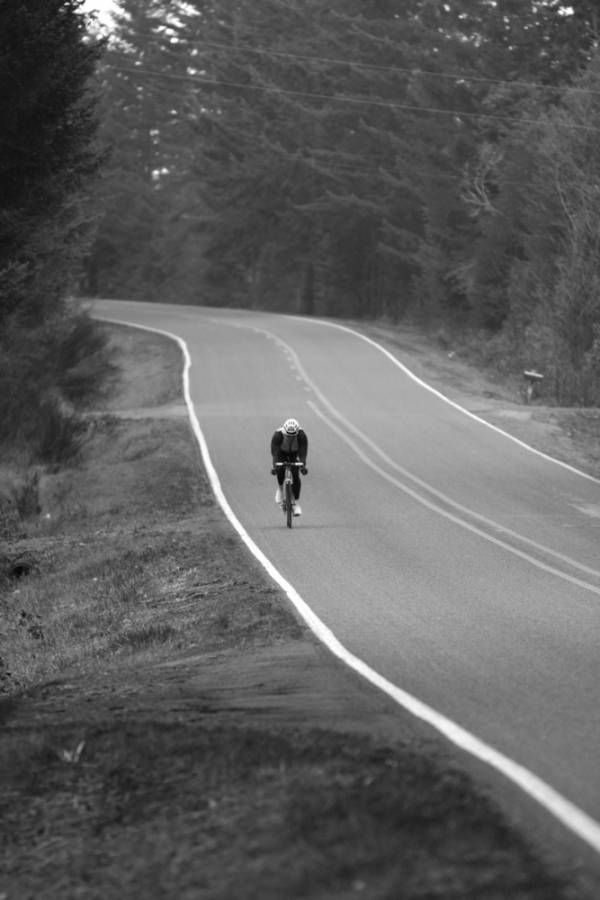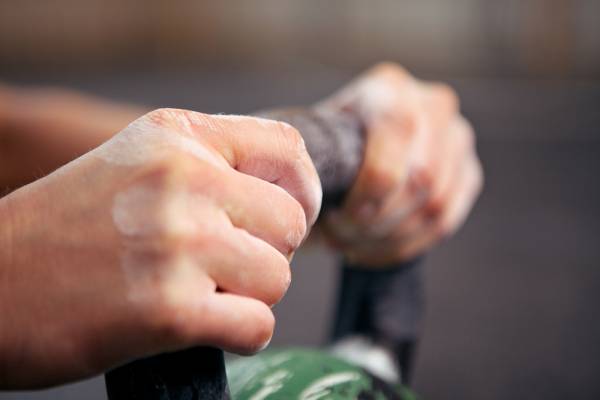My life changed on May 13, 2011. It was a Friday.
The “click, click, click” sound from tightening the buckle on my bike shoes echoed through my empty house. The morning sun was bright and the weather was ideal for a ride but I didn’t venture out. Trapped by my routine, I hid inside, balanced my orange road bike on training rollers, and spun alone in a dark storage room off the back of my house. Two hours passed. I didn’t want to stop because I knew that this would be my last ride for a long time, but I had somewhere to go. So when it was time, I unclipped, took a shower, and finished packing my suitcase.
By lunchtime, I was sitting at a table with a group of girls, crying over the reality of being forced to eat a portabella mushroom ciabatta sandwich. It was my first day in a residential treatment center for an eating disorder.
At face value, my story has been told before: Girl wants to get healthy. Girl develops eating disorder. Girl’s life spirals down the drain. Girl gets help and reclaims her life. Girl finds CrossFit and is forever changed. Strong is the new skinny. The number on the bar means more than the number on the scale. You get the idea.
Don’t get me wrong, in my world strong is the new skinny and I hope that following the Hatch squat program will pay off; however, when I take a closer look at my journey, I realize that I have evolved more deeply than simply prescribing to live life based on the latest motivational quotation found on Pinterest.
Let me back up and say that it took a few years (and a few therapists) to convince myself that I had a problem. What started out as a desire to be healthy morphed into an obsession with eating only clean, carb-free, low-fat, unprocessed, “good” foods. Panic attacks ensued if I had to eat in public, so eventually I stopped socializing. I punished myself with lonely hours of cardio if I ate a sandwich with cheese. I teetered on the edge of orthorexia for years.
I got caught in a dangerous cycle of thinking that when it comes to exercise, more is better. If I rode thirty miles today, then riding forty miles tomorrow must be better. Without agenda, things spun out of control. Three-mile runs turned into thirteen-mile runs. Hot yoga classes preceded two hours of intervals on the bike trainer. I lied about my schedule to workout. Rest days were nonexistent. Double and triple days were encouraged. Recovery nutrition didn’t apply to me. I never intended to flirt with this disease, but I was afraid to stop moving.
My quality of life faded as I got smaller. Music and laughter and fun in my home were replaced with yelling and crying. I was distant and pushed away my husband – my best friend – every chance I could. He became simply a roommate and I was too tired and stressed out to even care. Working out sustained me because the endorphins masked the pain, but I was miserable and no amount of exercise or control over my food could make it truly go away.
 The tipping point was when I realized that I couldn’t live without my daily cocktail of depression medications. After literally running and riding myself into the ground, I admitted to my husband that I needed help. I felt like a failure.
The tipping point was when I realized that I couldn’t live without my daily cocktail of depression medications. After literally running and riding myself into the ground, I admitted to my husband that I needed help. I felt like a failure.
I went from riding my mountain bike for 100 miles and winning cyclocross races to wearing sweaters in the middle of summer because I didn’t have enough body fat to stay warm. I felt weak and angry that I had ruined outdoor adventures and activities that used to bring me so much joy. I wanted to return to a place where I was happy and healthy, and I was stubborn enough to make that happen. Treatment forced me to get comfortable with being uncomfortable and I sucked it up. I didn’t have a choice. I needed to save my life and my marriage.
I came home from treatment six weeks later, fifteen pounds heavier, and with a new perspective on the definition of “healthy.” I no longer felt the need to punish my body and I reclaimed my love for delicious food. I learned how to acknowledge my honest feeling with my husband and my broken relationship was mended. With support from friends and family, I committed to embrace the social aspect of exercise and I rejected the thought of routine.
My life changed again on December 5, 2011. It was a Monday.
I walked into a CrossFit gym (thanks to purchasing a coupon online) and saw the words “Ball Buster” written on a whiteboard. The workout was five rounds of 30 seconds on, 10 seconds off of wall balls, ball slams, ball sit-ups, and double unders, and like so many others, I finished in a pool of sweat and was immediately hooked. The energy and encouragement from the coaches was infectious. I got a good workout that night, but more importantly, I had fun.
My entry to the world of functional fitness was not met without challenges. A well-designed WOD has a unique ability to transport your mind to the darkest depths of your soul. It gets inside your head and spontaneously, a 95-pound bar can suddenly carry the weight of your personal demons and force you to question whether or not you can go on.
When I first started CrossFit, I allowed workouts to take me to the edge of my dark place far too often. I was only six months into recovery and my internal perfectionist still had a voice, screaming that I was not strong enough, not fast enough, and not good enough. I don’t remember exactly why or how, but somewhere along the way I told that voice to shut up and I took control of the WODs, and my life. When I shifted my attention from focusing solely on the workouts to focusing on creating meaningful friendships with the members at my box, learning new skills, and eventually working toward becoming a coach, I felt happy – a feeling that overflowed into my life outside of the gym.
And then, when I stopped putting pressure on myself, the numbers on the bar went up.
During those first few months of CrossFit I heard things like “You’re so thin,” “You’ll crush this WOD because there’s running,” or “Go eat a pork chop!” No one ever directed those comments in a rude manner and truthfully, they were right. I was (and still am) thin for my 5’9’’ frame. I would respond, “I know, I’m working on it,” while thinking to myself, “If only they knew what I used to look like.”
 For a long time, only a handful of close friends and family knew about my stint in treatment because I was ashamed of the road I allowed myself to travel. I’ve since gotten over those feelings, and while I’m not inclined to yell it from a mountain top, I won’t shy away from telling my story. I want to dispel the preconceived notion that people with eating disorders are vain and want to look like models. I’m human and I’ve learned from my mistakes. Everyone battles something and we don’t have to fall into extremes to realize that occasionally we need a little help. I’m alive because I was strong enough to ask for help.
For a long time, only a handful of close friends and family knew about my stint in treatment because I was ashamed of the road I allowed myself to travel. I’ve since gotten over those feelings, and while I’m not inclined to yell it from a mountain top, I won’t shy away from telling my story. I want to dispel the preconceived notion that people with eating disorders are vain and want to look like models. I’m human and I’ve learned from my mistakes. Everyone battles something and we don’t have to fall into extremes to realize that occasionally we need a little help. I’m alive because I was strong enough to ask for help.
In therapy, I learned how to maintain a healthy relationship with food and exercise. Oddly enough, CrossFit taught me how to embrace rest. There are days when it’s more fun to skip the gym, sit in my backyard, drink a beer, and eat ice cream, so that’s what I do. Sometimes the feeling of knowing that I can quiet my mind when life’s chatter gets loud feels better than the endorphin high after a workout.
Occasionally, I still have demons that try to sabotage my workout. Even though I know better, I am quick to judge when I fail a lift or when others are making gains leaps and bounds ahead of me. My journey to becoming a trainer has played an integral role in my recovery. I shadow experienced coaches, read articles, and watch videos in my never-ending quest to learn because growth is a process. When I feel frustrated, I have a husband, coaches, and a gym full of friends to help me remember where I started, which was as a girl who could barely clean an empty barbell.
Although seemingly trite, I have learned to never underestimate the value of choice. Every day I choose to be happy. Every time I return to the bar when it gets hard, I am choosing to be emotionally strong when I am outside of the gym. The physical strength I gain is just gravy.
Photos courtesy of Shutterstock.






